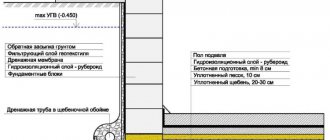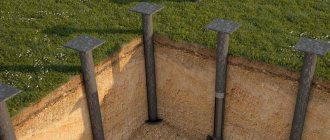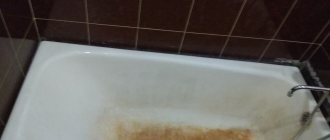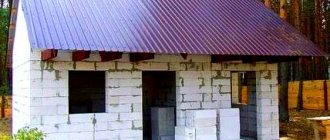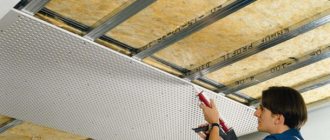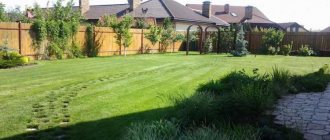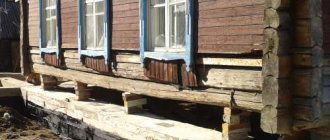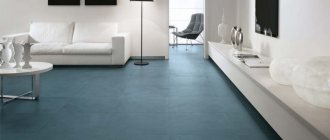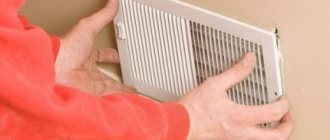Under the influence of moisture, concrete is destroyed, which causes deformation of the entire structure over time.
To protect the foundation from the destructive effects of moisture and subsidence of load-bearing walls, it is necessary to take care of high-quality waterproofing.
You can complete the entire range of work yourself, since the choice of building materials today is great. Familiarity with the basic methods of protective measures will help you choose the best option and avoid mistakes when performing waterproofing work.
How to properly waterproof a foundation with your own hands, read on.
How does water and moisture affect the foundation of a house and does it need waterproofing?
Waterproofing the foundation is not just important, but very important and must be done, otherwise you risk the gradual destruction of your foundation and the possible appearance of cracks on it. Basically, the foundation is destroyed due to exposure to water, moisture and aggressive environments. If it is not properly protected, the structure of the concrete (or brick) from which it is made will absorb moisture and water, which will freeze in winter at sub-zero temperatures and thaw in the spring, forming pores, voids and microcracks in the concrete. These microcracks and voids will increase with each season and can subsequently lead to the formation of more serious cracks and damage.
Here it is important to know that if waterproofing work is carried out correctly on the outside of the structure and materials are selected correctly, then water will not be able to penetrate the concrete and, accordingly, will not be able to destroy the foundation from the inside. Concrete is a sponge for water; it absorbs it, which will subsequently not only have a negative effect on it, but will also lead to the destruction of metal reinforcement. Which, in the end, will lead to a decrease in the strength of the foundation, as well as the penetration of moisture and liquid into the interior of your home.
Application methods
Insulation installed using different methods has different purposes and functions . Waterproofing is distinguished:
- vertical;
- horizontal;
- internal;
- external
Vertical
Vertical waterproofing of walls and foundations provides protection from the “pressure” of water in the soil. Vertical waterproofing is most often used, since thanks to it the foundation of a residential building will be reliably protected from corrosion.
Vertical insulation is divided into internal and external. It is recommended to use both of these methods whenever possible.
External insulation is water-repellent . Creates a protective screen. It is applied immediately after installing the foundation and before backfilling it.
Internal waterproofing is an additional method, although it is often used when external finishing is not possible. The interior finish is anti-corrosion, it does not allow moisture to penetrate and destroy the base from the inside.
Read about internal waterproofing of the foundation here, about vertical waterproofing here.
Horizontal
Laying insulation parallel to the ground is a method that is used when there is a basement to prevent moisture from penetrating into the house. Some types of concrete lead to capillary rise of moisture from the basement. Because of this, the ground floor is also damp, and mold appears on the walls.
Laying a horizontal layer of insulation cuts off the possibility of moisture penetration through the foundation. Details are in this article.
Waterproofing the foundation structure from groundwater and water
Groundwater can be different. They can be classified according to the degree of aggressiveness to concrete and metal. In all highly aggressive environments, it is necessary not only to horizontally protect the foundation from them, but also to use waterproof grades of concrete when constructing it. The level of aggressiveness in groundwater can be determined by conducting laboratory tests. To protect a structure from groundwater rivers, it is necessary to correctly and promptly make horizontal insulation of the concrete base and foundation slab; for this, there are different types of materials and methods, which you will learn about in the continuation of this article.
What factors should be considered when creating a foundation design?
When properly designing waterproofing of a house below ground level, both vertical and horizontal, a number of factors must be taken into account:
- Concrete grade;
- Ground water level;
- Degree of soil moisture;
- Type and depth of the foundation;
- Propensity of soils to frost heaving;
- Heterogeneity of soil composition.
Strengthening the brick base
A more optimal option for strengthening a brick building is the construction of “bulls”. To do this, perform the following actions:
A reinforced frame is constructed, mounted to a concrete pad. It is made using welding.
- The corners of the base are exposed - a hole 1 m wide is dug around them. The depth of the hole should be 0.5 m greater than the installation depth of the pillar.
- Frames made of reinforcement are installed in it.
- Fill the hole with concrete mortar.
This technology requires a careful and careful approach. Work is carried out only in good weather. An easier way is to reinforce the pillars with a special belt. To complete the process you must:
- Divide the perimeter into segments of 2 m. Dig a ditch on each of them (with a depth equal to the depth of the foundation).
- Holes for reinforcement are made in the column.
- A frame made of pieces of reinforcement is installed in the trench.
- The structure is filled with concrete.
Types of foundation waterproofing - technologies and materials
When installing protection and waterproofing of a concrete or any other foundation, two types of insulation must be taken into account: Vertical protection and horizontal.
Vertical and horizontal waterproofing of the foundation
At the moment, waterproofing can be divided into several types. The first type is vertical. The second type is horizontal. And the third type is internal.
Important: It is recommended to apply any insulating compounds only from the inside only if it is not possible to waterproof the outside.
Experts distinguish between horizontal and vertical waterproofing. In this case, the terms horizontal and vertical refer to the direction in which the waterproofing material is applied, which primarily depends on how much moisture you want to protect your home from. This could be rising moisture, also known as capillary moisture, in which case we are talking about horizontal insulation. If the water presses from the side, then we will talk about installing vertical insulation.
Vertical and horizontal waterproofing
In any case, with proper and comprehensive protection of the foundation of your house or building, you need to install both horizontal and vertical waterproofing. In each specific case, the type of waterproofing and the technology for its installation will be selected, taking into account the operating conditions of the foundation. What is usually provided for in the design of a house or building.
Scheme of vertical and horizontal waterproofing of the foundation
Horizontal or cut-off waterproofing of the foundation
Horizontal insulation is the so-called cut-off waterproofing. At the construction stage, it is carried out using special membranes separating the foundation and walls. At the stage of repair and operation, cut-off waterproofing is most often performed by injection and its task is to create a cut-off or barrier to moisture and water. The cutoff can be done both from the outside of the building and from the inside. Basically we are talking about cases of capillary moisture rising from the foundation slab up the walls. In such cases, the so-called cut-off waterproofing is performed - the cold adjoining seam is opened (using a fine), then compacted layer by layer with a non-shrinking compound or expanding sealant, and then injected. Injection resin is injected into the cold joint, thereby forming a horizontal cutoff that prevents capillary moisture and water from rising up the wall.
During the construction phase:
Cut-off waterproofing with membrane
At the repair and operation stage:
Cut-off waterproofing by injection
The most popular methods and materials for vertical and horizontal waterproofing of foundations are:
- Pasted and welded
- Mountable
- Coating
- Liquid rubber
- Penetrating
- Injection
Pasted and welded
Fused roll waterproofing similar to built-up bitumen materials from Technonikol - this type of insulation is applied or fused in several layers mainly from the outside and has obvious disadvantages, such as the presence of seams, which is a weak point. The material is also characterized by the absence of 100% adhesion to the surface. Accordingly, fused membranes have cavities and voids where liquid can stagnate and leak. The material is installed on the surface using a torch and fire.
Waterproofing of a foundation slab with fused rolled insulation
Mountable
This type of insulation is mounted on the surface using special clamping elements, for example, strips. The most popular materials in this category are TPO and PVC membranes. Different pieces of membranes are connected using a hair dryer and hot air. In most cases, PVC membranes are applied in 1 layer.
The seams and complete lack of adhesion make this material very vulnerable to water penetration.
Waterproofing with PVC membrane
Coating
Coating bitumen waterproofing - these compounds are used externally in 2-3 layers, and their reliability depends on the composition and the manufacturer (the more expensive, the better and more reliable the material will be).
Liquid rubber
Two-component liquid rubber of the FlexLock type from HYDRO is an elastic and seamless coating that is applied by spraying and has 100% adhesion to the surface. This is the most effective and most reliable material for waterproofing external concrete surfaces, such as a concrete slab or walls located below level 0.
Waterproofing a foundation slab with liquid rubber
Waterproofing the foundation with liquid rubber
Penetrating – Foundation waterproofing with Penetron
To seal the foundation from the inside, you can use various penetrating technologies and compositions, including Penetron brand materials, but do not forget that penetrating mixtures, which have the property of forming a so-called film of crystals, do not work in all cases and not for on all grounds. Not Penetron or other penetrating compounds will not work on brick bases, blocks and poorly vibrated areas of concrete, as well as on areas where reinforcement meets concrete. For the above reasons, before using such materials, you need to very carefully study their characteristics, and also consult with a contractor specialized in waterproofing (it is best with a company that deals with all types of waterproofing, and not just Penetron - such a company will be the most objective).
Penetrating waterproofing: how it works
Injection waterproofing of the foundation
To perform injection work, holes are drilled from the inside in the concrete (so-called boreholes), packers are inserted there (hollow tubes through which injection resin is injected) and a two- or one-component polyurethane composition is injected under pressure into the concrete (special equipment), filling all cracks and voids . Injection waterproofing is used both to protect the concrete body and to seal cold joints and foundation concreting joints from inside the building itself.
Scheme of operation of injection waterproofingMaterials for foundation waterproofing?
For work related to waterproofing, there are a number of different materials that differ in installation method, characteristics, properties, components, reliability, durability and price. To understand the main differences between the most famous waterproofing systems, as well as an examination of their advantages and disadvantages, you can study the following table:
| Liquid rubber | Bitumen-based coating mastic | Bitumen-based weldable materials | PVC membrane | Penetrating compounds | |
| Installation method |
|
|
|
|
|
| Working with negative water pressure | No | No | No | No | Yes |
| Number of layers |
| 2-3 layers | 2-3 layers | 1 layer | 1-2 layers |
| The need for pre-priming | Yes | Yes | Yes | No | No |
| Seams and joints in waterproofing coatings | No | No | Yes | Yes | No |
| Adhesion to the base | 100% | 100% | 20% | No clutch | 100% |
| Elasticity coefficient | 600-800% | 50-200% | 10-20% | 10-20% | 0% |
| Installation speed m2/1 day | 400-600 | 20-50 | 20-50 | 30-60 | 20-50 |
| Warranty period for work | 7 years | 3-5 years | 3-5 years | 1-2 years | 1 year |
Price
Calculation of the cost of waterproofing is based on the area of the foundation and the materials used. In this case, you need to take into account:
- film materials are laid with an overlap of 15-20 cm;
- the dry residue of the mastic should be 3-6 mm;
- for rolled materials, you need to consider the purchase of reinforcements for the joints.
It is worth considering the complexity of the work. Bitumen is one of the cheapest waterproofing materials, but the cost of processing is quite high.
The price for foundation waterproofing, depending on the material, can vary from 20 to 200 rubles per square meter . You can find out what the price of foundation waterproofing consists of here.
Repair, installation and waterproofing works depending on the type of foundation
It is best to entrust the work of installing proper waterproofing to an experienced and professional organization; it will be the one who will be able to not only choose the correct method for installing or repairing a waterproofing coating, but also carry out its installation correctly.
It is the correctness and adherence to the installation technology that determines how well the foundation of your building will be protected and how long this protection will serve you without the need for repair or replacement. Do not forget that if the waterproofing is installed incorrectly, it will most likely have to be repaired after a year or two, and these are serious additional costs associated with the following work:
- Dismantling the made blind area (if any)
- Development of soil around the underground part of the house, to its entire depth
- Dismantling wall insulation (if any)
- Removing the old waterproofing coating
- Installation of new waterproofing
- Reinstallation of insulation
- Backfilling of soil and restoration of the blind area
Important: Most waterproofing coatings cannot be repaired locally, since it is impossible to determine from the location of the leak from the inside where the water is entering from the outside, so the entire coating must be completely replaced.
You can find 7 rules on how to find a professional waterproofing company or contractor and not make mistakes in the article - Contractors, companies and firms for waterproofing and drainage
Waterproofing strip foundation
The strip foundation can be made of FBS blocks or poured from concrete. When insulating a strip foundation, it is necessary to take into account both horizontal and vertical waterproofing. Horizontal protection is installed on the horizontal surface of a strip of FBS blocks or concrete and serves as a cutoff between the strip foundation and the future walls of the house. This cutoff will prevent capillary moisture from rising and being absorbed into the walls. Vertical protection is applied to the vertical surface of the tape located below the ground level.
The following materials can be used as a waterproofing composition:
- Welded;
- Coating;
- Liquid rubber – recommended;
- PVC membranes;
Strip foundation waterproofing scheme
Waterproofing of columnar and pile foundations
In this type of structure, only horizontal protection needs to be provided. Installation of waterproofing is carried out on the surface of the grillage or supporting element. The main task of insulating pile foundations is to prevent capillary rise of moisture and its further impact on the walls of the house.
For this type of structure you can use materials such as:
- Fused insulation;
- Coating mastics;
- Membranes;
- Liquid rubber.
Scheme of waterproofing grillage and columnar foundation
Pile foundation waterproofing scheme
Monolithic slab foundation
When constructing this type of foundation, it is necessary to provide high-quality and reliable waterproofing of the horizontal base, since subsequently repairing the protection made will be impossible.
The following products can be used to waterproof a monolithic slab:
- Welded bitumen membranes;
- PVC membranes;
- Bitumen mastics;
- Liquid rubber – recommended.
Important: When installing any type of foundation, it is recommended to install a high-quality drainage system around it at a depth of 0.3-0.5 m below its level. The drainage system located just below the foundation will take in the water that will approach it from the side and the water that is located under it. This will relieve the water pressure on the concrete and increase the lifespan of the waterproofing system.
Common mistakes, valuable recommendations
Defects made when arranging foundation waterproofing lead to a reduction in the service life of materials and destruction of the foundation of the house.
These errors include:
- Saving on drainage pad. If this is not done, the lower part of the base of the building will constantly come into contact with moisture. It is recommended to fill it with sand and gravel after compacting the soil. Its task is to remove moisture from under the house.
- Unevenly poured foundation due to poor-quality formwork and violation of concrete pouring technology. It is recommended to level the walls and the horizontal part of the foundation and knock down the protrusions. Rolled strips cannot be attached perfectly to uneven surfaces.
- Violation of the integrity of 1 vertical waterproofing barrier. Gaps, cracks, non-overlapping waterproofing materials that are laid on a drainage pad along the bottom of a trench or pit before pouring the foundation. It is necessary to glue the joints and lay the sheets with an overlap of at least 15 cm.
Inadequate choice of building materials for vertical waterproofing. When choosing, you should take into account climatic conditions and the location of the building. It is recommended to consult specialists who will select the best option.- At the corners and joints of the base and the walls being built, the waterproofing is done poorly. In these areas, the materials must be firmly fixed; any loose materials must be removed and replaced with new ones.
- No primer was used. To ensure a good fit of materials, all surfaces must be treated with a primer, otherwise all waterproofing work will go down the drain:
- the applied compounds will peel off;
- you will have to dig out the foundation around the perimeter;
- remove all old material;
- perform the entire range of waterproofing works, already following the technology.
- The use of roll materials inside the building, neglecting external waterproofing. Under the influence of moisture from the outside, rolled materials on the internal walls of the foundation swell and peel off. For interior work, it is recommended to use polymer-cement compounds.
- Incorrect timing for waterproofing. It is better to carry out work in dry weather.
- The waterproof barrier is level with the ground. The upper part of the protective layer should be located at least 200-300 mm above the ground level.
- Lack of storm sewer, drainage system and blind area.
Everything you need to know about foundation waterproofing can be found in this section.
Do-it-yourself waterproofing of the foundation of a private house
Protecting the foundation of a building or a private house from groundwater is a very responsible job, but if desired and with proper knowledge of the technology, the owners of private houses and summer cottages will be able to do it with their own hands, for this they will need to take the following steps:
- Select a suitable technology and material, the design of which does not require the use of special equipment (for example, an installation for spraying liquid rubber or polyurea);
- Carefully study the technology and manufacturer’s instructions for installation, repair or installation of a particular coating;
- Take all measures to organize the workplace and safety precautions when carrying out work with your own hands;
- Carefully prepare the surface before installing waterproofing yourself;
- Most materials require preliminary application of a primer (primer, to improve the adhesion of the waterproofing coating to the surface).
- Apply the waterproofing coating yourself, strictly following the manufacturer's instructions.
- Protect the waterproofing layer from subsequent mechanical damage (for example, when backfilling).
In this video you can see detailed instructions for waterproofing a foundation with your own hands:
Surface preparation
The main problem that a master faces when working with the foundation of a built house is the need to destroy the blind area and remove the existing finishing. If possible, the foundation should be excavated to its foundation. Next, to ensure good adhesion of the protective coating to the structure, the surface is thoroughly cleaned of soil and debris.
Inspecting the integrity of the structure, repair all cracks and chips on the surface, first using a primer, then a special plaster. The application of the protective coating begins only after the repaired areas have hardened. Waterproofing the foundation of an old house can be done in several ways.
